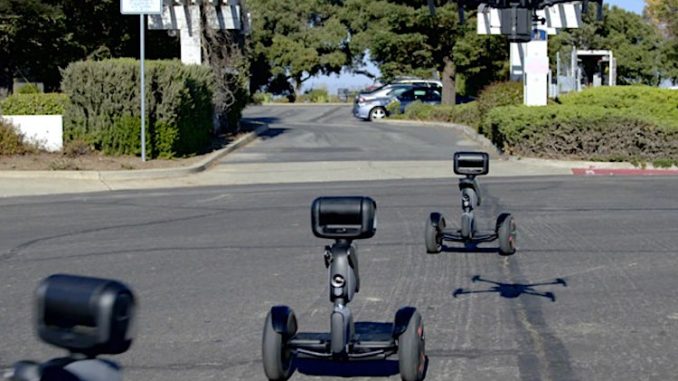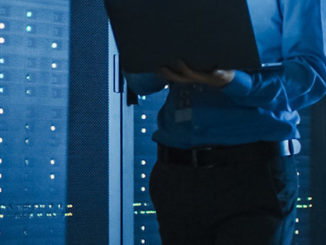
Recent robot launches here and across the Tasman are a reminder that security robot technology continues to advance towards mainstream commercialisation. This, writes Nicholas Dynon, is a good thing.
In the past couple of years, NZSM has continued an editorial interest in security robotics and autonomous systems, with particular focus on the US-made Knightscope K5 and the Chinese Anbot. Bearing a striking resemblance to each other, these heavy, almost-adult-height bollards-on-wheels have been – like their less charismatic forebears – touted as the future of security guarding.
The point of difference that these robots – or autonomous systems – offer is that they present a technology-based alternative to the use of humans that is both cheaper and safer.
But their limited ability to cover uneven terrain and to interact intelligently with their environment suggests that the technology is not quite there yet – at least not in a form that keeps costs below their ‘cheaper than a human guard’ claims… or that necessarily makes them safe.
In July 2017, a navigationally-challenged K5 was found camera-down in a public fountain, having apparently veered off course while patrolling a commercial area in Washington DC. In another incident, a K5 allegedly knocked down a 16-month-old toddler in a Silicon Valley shopping centre in an inadvertent hit-and-run.
Typically, security robots are made up of two main parts: an unmanned ground vehicle (UGV), and special-purpose equipment, such as cameras, sensors and – potentially – weapons. But limitations in both mean that their deployment applications have been limited in two key ways.
Firstly, although some models have been described as ‘cute’ and have even been ascribed human-like qualities, robots are yet to develop the smarts and on-the-spot decision making grunt behind the charisma to fill concierge and other public-facing roles.
That they might be able to eject drunken patrons from bars, provide directions to accidental trespassers, or make reliable tactical decisions based on first-responder intelligence, remains the stuff of science fiction.
Secondly, although they can move quick (up to 18km/hr), wheel mounted UGVs, for example, require relatively flat, unobstructed ground, and outdoor robots prefer fine weather. This keeps them largely factory, warehouse and shopping mall-bound.
With the recent launches in Auckland and Sydney of two new security robots, however, we are witnessing a new generation of UGV that’s taking us a step closer to broader deployability.
A new, more mobile generation
Just a few weeks ago at Sydney’s Luna Park, security company ACES (Australian Concert and Entertainment Security) introduced its new offering, an intelligent security robot called ‘Nimbo’, which is claimed to offer an autonomous, smart patrolling solution enabling organisations to modernise their security teams.
With its Segway-based design, Nimbo offers terrain flexibility and reliability not seen in other robots, including a unique “Ride-On Mode” allowing a human guard to jump on and ‘hitch a ride’ when necessary. It has front and back facing cameras.
Andrew Tatrai, the Founder and Managing Director of ACES, said that a hallmark of successful companies is an ability “to solve customer problems with technology and practical experience to find products that add real value.”
The addition of the Segway technology is more than gimmick. One can only imagine that if its standard Segway assembly were to be replaced with the ruggedised, all-terrain Segway x2 SE model, the Nimbo would present a credible solution for even rural deployments.
Enjoying this article? Consider a subscription to the print edition of New Zealand Security Magazine.
In February, New Zealand’s Advanced Security Group announced the arrival of their fully autonomous security robot.
The ASG offering, which appears to be based on the SMP Robotics and RAD (Robotic Assisted Devices) S5 model, is equipped with sensors that can detect obstacles and objects in any kind of weather. The S5 can follow a set route and run for 12 hours without needing a charge. It also has a 360-degree camera on top to capture all views while on patrol.
ASG claims its robot can patrol continuously for up to 20 hours, and can autonomously re-charge itself. It can be used effectively indoors or outdoors to cover large areas.
The potential ability of the S5/ASG offering to operate in an integrated fashion alongside security UAVs can increase its range and effectiveness, particularly in open, outdoor settings.
“The robots are faster, safer and more cost effective than the traditional security guard model” said Group CEO, Mike Marr. According to ASG, their robot can work alongside traditional guards saving customers 30-50 percent, with pricing starting at just $12.00 per hour.
Low-cost alternative not a threat
The cost aspect is an important one with significant potential implications for the security industry. In markets where robots such as the K5, Nimbo and S5 have been launched, their makers have all claimed that they cost less per unit than the minimum wage to operate.
But talk of robots as ‘replacements’ of human guards is perhaps a little misleading, and overly distopian. Sensational headlines, such as “Security guards – this robot wants your job” (which appeared in Computerworld earlier this year), pit the futures of human security guards and their robotic counterparts in opposition as the former find their jobs being taken away by the latter.
For an industry characterised by the widely acknowledged irony of low wages and an undersupply of labour, the prospect of robots coming in and taking over some of the more monotonous, lower value guard roles actually sounds like a potentially positive development.
If anything, we should be understanding and talking about the encroachment of robots into manned security as a desirable prospect, and one that we should be planning for and embracing. It’s about time we quit talking about security robots in the sometimes dystopic, sometimes comedic terms we’ve become accustomed to.
Security robots won’t end up ‘replacing’ human guards wholesale. But they will allow a guard force to be optimised and committed only to incidents where a threat has been properly assessed via the data they stream back to a centralised operator.
For all of their onboard smarts, which are only set to get smarter as sensing, analytics and AI technologies evolve, security robots require human operators. They need humans able to confirm what they see when an alarm is triggered, to make decisions in relation to whether to respond (and how), and – where required – to execute the response.
There will always be a need for human security guards, it’s just that security guards will be required to possess more specialised skillsets, including the ability to direct – and to make value-added decisions on behalf of – fleets of lower cost security robots. And that’s an exciting prospect.









